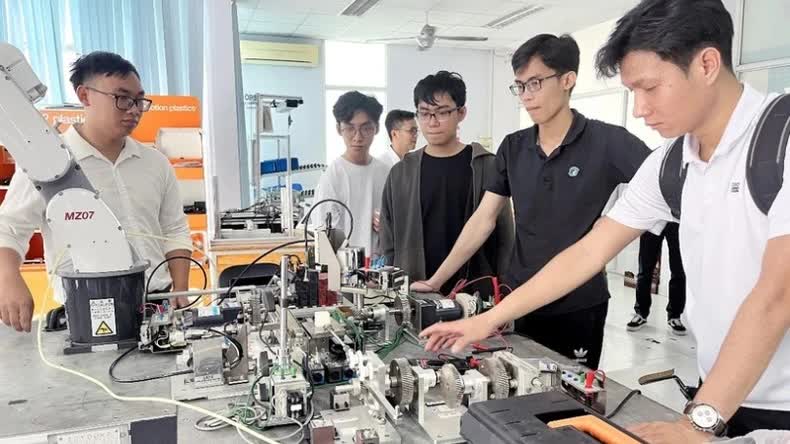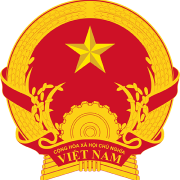
Introducing semiconductor circuit boards at the Da Nang Semiconductor Day 2024. (Illustration photo: VNA)
Vietnam — an ideal destination for the semiconductor industry
In recent years, the global semiconductor industry has recorded remarkable growth. In 2023, total revenue is estimated at 529 billion USD. In the context of the world witnessing the rapid development of a number of industries such as electric cars, telecommunications, cloud computing, and artificial intelligence technology, the semiconductor industry is expected to continue to grow strongly and reach 1 trillion USD by 2030.
This boom creates great opportunities for many countries to participate in the semiconductor industry, providing opportunities for developing countries to restructure and improve the efficiency of semiconductor industry development.
The prime minister’s Decision 1018/QD-TTg (dated September 21, 2024) on the strategy for the development of Vietnam's semiconductor industry to 2030 and vision to 2050 was issued in the current context with great significance with the mission of promptly grasping and taking advantage of opportunities in the context of the shift in the global semiconductor supply chain, while laying the foundation for the sustainable development of Vietnam's semiconductor industry.
Vietnam has the opportunity to become one of the global semiconductor and electronics industrial centres thanks to important factors such as special geopolitical advantages, being a safe destination and having the leading semiconductor industry development potential compared to some countries in the region.
In addition, the Party and State have given top priority to the development of the semiconductor industry, passing many resolutions at the highest political level with specific and specific policies to prioritise the development of the Vietnamese semiconductor industry.
Vietnam has lower living costs, labour costs, and electricity prices than countries such as Malaysia, Thailand, and Singapore. In addition, support policies from the government on exemption of income tax, land tax, import and export tax, etc., helps reduce costs for semiconductor and electronics enterprises investing in Vietnam.
Vietnam, located in the centre of the region that accounts for 70% of the global semiconductor industry's production output, is among the fastest growing countries and has strategic partnerships with many semiconductor powers.
Vietnam is also one of the countries with the largest number of free trade agreements (FTAs) in the world and the largest in the region, with 13 FTAs. It is among the leading countries in global trade growth, thereby creating favourable conditions for the export of electronic products, especially semiconductor chips.
 Students practice research at the Ho Chi Minh City High-Tech Park Training Centre. (Photo: VNA) |
In addition, Vietnam also has the advantage of a young population with STEM (science, technology, engineering, mathematics) capacity, capable of quickly meeting the human resource needs to develop the semiconductor industry.
The semiconductor industry is an important sub-sector of the digital technology industry. To develop the digital technology industry, including the semiconductor industry, at the 8th Session of the 15th National Assembly, the government submitted the draft Law on Digital Technology Industry to the National Assembly.
The draft law stipulates the chapter “Semiconductor Industry” instead of “Semiconductor Microchips” to ensure the comprehensiveness, comprehensiveness, and completeness of the stages of semiconductor industry activities, in accordance with the goals and management objectives of, and remaining in sync with, the Semiconductor Industry Development Strategy. The draft assigns the government to develop its own strategies and policies for development in each period.
This is a very important content in the context of the semiconductor industry becoming a key industry that plays a role in influencing economic and social development, while promptly meeting practical requirements to anticipate the wave of investment shifts as many large global corporations are expressing interest in investing in Vietnam.
Clearly identifying the semiconductor industry as an important activity in the digital technology industry, the draft law provides regulations on principles, classification of activities, mechanisms, and specific policies, giving more priority to the development of the semiconductor industry.
There will be policies to promote development and risk-based management of AI
 Artificial intelligence exhibition booth at the Artificial Intelligence Festival. (Illustration photo: VNA) |
In addition to regulations on semiconductor industry development, the draft Law on Digital Technology Industry also devotes a chapter to regulating artificial intelligence to ensure the encouragement, development, and application of artificial intelligence and measures to manage and minimise risks, thereby helping this digital technology to be exploited responsibly, promoting trust, and ensuring human safety.
According to Statista, the global AI market size is expected to reach 184 billion USD by 2024. The projected market size shows an annual growth rate (CAGR 2024-2030) of 28.46%, resulting in a market volume of 826.70 billion USD by 2030.
In recent years, Vietnam has continued to record remarkable progress, ranking 5th out of 10 countries in ASEAN and 59th out of 193 countries and territories in terms of artificial intelligence readiness on a 2023 report by the UK-based Oxford Insights.
Notably, this is the third consecutive year that Vietnam has surpassed the global average, affirming its strong development in the field of artificial intelligence.
This impressive result not only reflects the investment and efforts to develop AI in Vietnam, but also clearly demonstrates the trend of forming an artificial intelligence industry.
Vietnam possesses many favourable conditions to promote AI, from the government's support policies and potential human resources to the readiness for international cooperation and attracting foreign investment.
Not stopping at potential, Vietnam has recorded substantial progress through large digital technology enterprises investing heavily in the AI field, such as Viettel, VNPT, Mobifone, FPT, CMC, and VinAI.
Many enterprises have achieved outstanding applied research achievements and contributed to building the foundation for a developing AI ecosystem, helping Vietnam get closer to the goal of becoming a regional technology centre.
Artificial intelligence is one of the breakthrough digital technologies that has a great impact on many industries and fields. In addition to bringing many benefits, AI also poses challenges in terms of risks to people and society.
The draft Law on Digital Technology Industry emphasises that artificial intelligence serves the prosperity and happiness of people, puts people at the centre; improves productivity and work efficiency; provides inclusive, fair and non-discriminatory access; respects ethical values, human rights, and interests; protects privacy; and ensures transparency, explainability, accountability, and the ability to control algorithms and artificial intelligence models, etc.
The draft stipulates risk management for artificial intelligence systems; responsibilities of parties involved in the development, provision, deployment, and use of artificial intelligence systems; as well as labels and processes and procedures for labelling digital technology products created by artificial intelligence systems.
In addition, the draft law also stipulates a mechanism for controlled testing of digital technology products and services. This is a very important and breakthrough mechanism that creates a strong enough legal corridor to support the development of the digital technology industry in general and artificial intelligence in particular.
In addition, the mechanism for testing digital technology convergence products and services is also one of the breakthrough policies in the draft law, allowing testing with limited scope in terms of space, time, scale, and testing subjects for digital technology convergence products and services, new business models created by digital technology convergence that do not have any laws to regulate or are different from the provisions of current laws.
Based on the experience of some countries in the world that have issued laws regulating this issue, such as the Republic of Korea, Japan, and Taiwan (China), the government has proposed to develop this regulation to promptly respond to the rapid development and convergence of digital technology in industries and fields, creating a legal corridor to promote digital technology convergence products and services.
The testing mechanism will form the process and principles for reviewing testing applications of enterprises and clearly stipulate the focal point for receiving, processing, and deciding to allow testing on a case-by-case basis based on the scope and field of testing to ensure increased decentralisation, speed, timeliness, and convenience for enterprises to test digital technology products and services.
